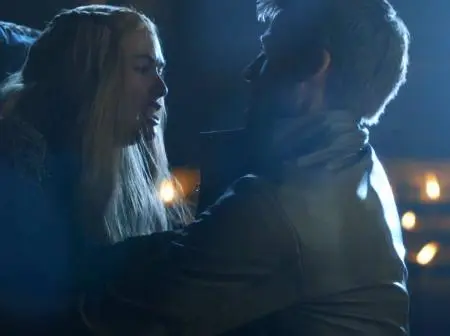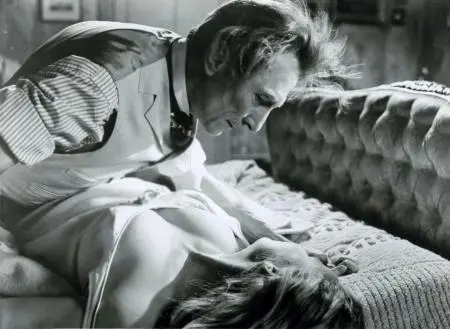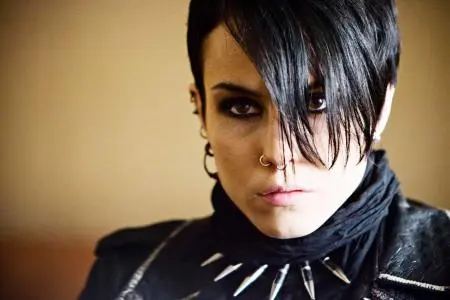This is a trope that is so pervasive, you probably don't always register it when you see it—especially in horror films and fiction, though it appears quite regularly in non-genre titles as well. I'm talking of course about the threat of rape (or in numerous cases the successful rape) of a prominent female character for the sole purpose of drumming up tension and fear.
Now, let me state right away that I know all too well how delicate a subject this is, and in no way do I want to trivialize it—in fact, to me that is the distinct problem with this trope, that it all too often trivializes rape for the sake of a good scare. But just know going into this, I plan to unpack this subject as neatly as I can and examine—with examples, of course—all the flaws of this trope, as well as the potential proper ways to use it. Myself and LitReactor are not here to unduly make anyone uncomfortable, and we apologize if this discussion does just that.
Defining the Trope
Let's begin by first outlining what it is I'm not talking about, just so we're clear. I won't be addressing rape revenge narratives, as those are a separate animal, because, for better or worse, those stories directly deal with the aftermath of rape, the psychological toll it takes on its female protagonists (examples include everything from cult films like I Spit On Your Grave and Ms. 45 to the critically-acclaimed Hard Candy and Irréversible). I'm also not talking about rape revenge fantasies with a male protagonist, in which the assault (and often murder) of their wives, lovers, family members, etc. acts as a catalyst for taking justice into their own hands (including the Charles Bronson-starring Death Wish and its numerous sequels, as well as Christopher Nolan's breakout film Memento, Shakespeare's Titus Andronicus, and even Joe Hill's Horns).
No, what I'm talking about are individual scenes of attempted and/or successful rape within a broader narrative, ones that aren't focused on the act and its aftermath, but rather scenes that mostly feel untethered from the broader story and could easily be substituted for another fear-inducing and/or tension-building scenario.
An expanded definition and explanation of this type of scene comes from Laura Hudson via Wired. She writes:
One of the reasons that creators of media like to include rape in their work is specifically because it elicits strong feelings, even when divorced from all context and consequences. Think of it as a recipe for cheap drama: Take a story, add one rape, stir vigorously, and presto—instant emotional reaction! This is both incredibly lazy and callous, but it works, so people keep doing it.
A good example of this comes from Game of Thrones, specifically Jaime's rape of Cersei near the beginning of season four. There was another rape scene that caused much ire amongst fans, that being Ramsey's assault on Sansa, but while that moment in the show certainly has its flaws, this mostly forgotten moment glares far more strongly with its utter pointlessness. (For a direct discussion of the Sansa scene, see Leah Rhyne's piece from LitReactor here). If you're unfamiliar with the show or the scene, it happens just after the death of Jaime and Cersei's son, the much-loathed King Joffrey. As the parents (who are also brother and sister) observe their child on his deathbed, Jaime turns his comforting embrace into a sexual advance, which Cersei rebuffs. But Jaime overpowers her and has his way, despite his sister/lover's struggles. One suspects the producers and writers of the series wanted to show audiences they shouldn't feel sympathetic toward Jaime Lannister too much, as they'd just spent a fair amount of time showing us that he can be a good guy. This was a reminder that Jaime's still a bad guy. Problem is, in George R.R. Martin's novel A Storm of Swords (upon which the fourth season of the series is based), Jaime and Cersei have consensual sex in their family's tomb, with their dead inbred son's corpse hovering over them, with the point perhaps being that these siblings should really just stay far away from each other, as nothing but perversity and destruction comes out of their union.
But more galling than that, after Jaime's repugnant act in the series, the producers and writers never acknowledge it again. There's perhaps some brief iciness from Cersei toward Jaime, but overall the matter is completely forgotten, raising the question: why even use rape in this scenario, if it was ultimately never to be dealt with? Moreover, if the point is to show audiences that Jaime is still a bad guy at the end of the day, why stray from the source material in such a blunt and uncouth way, when Martin's original scene delivered the exact same message while at the same time giving Cersei agency? Merely for shock value? Were the writers struggling to fill their rape quota? There aren't many answers to this other than fan and critic theorizing, and it's doubtful we'll ever really know why the series veered off into this delicate territory.
More Examples
I'm hard pressed to find more instances of this trope in recent literary fiction, no doubt due in part to the fact many publications do not publish stories with rape as a central threat or agent of fear, and even actively discourage writers from submitting stories containing such scenes (LampLight, Shimmer, and Gamut are but three). One egregious example is Ralph Robert Moore's "Drown Town," a novelette published in Black Static #43, in which a narrative centered on an ostensibly green female psychologist with perhaps a little too much "outside the box" training becomes trapped inside a prison's basement, due to a dam breaking and a subsequent flood, with a dangerous inmate she made wear a toilet seat around his neck (it's a long story). Moore switches protagonists, centering his attention on the woman's father, who puts on diving gear and goes after her. He finds her the captive of the prisoner, who—it's made more than apparent—has repeatedly assaulted his former therapist. The only way to save his daughter is to save the prisoner as well, by shackling attacker and victim together and leading them to the surface (the prisoner won't let them go in any other circumstance). A scuffle ensues in the water, and the prisoner dies, but one of the oxygen tanks runs out, forcing the father to give his air to the daughter. He makes it to land, but he held his breath too long, and as he dies on the shoreside his daughter spits in his face for forcing her to be shackled to her rapist.
There's a distinct air of sympathy in the writing toward the father, this poor man who did the only thing he knew to do to save his daughter's life, and how dare she be so ungrateful, zeroing in on the proximity of her attacker rather than seeing the bigger picture of her survival. Is the writer here attacking the ostensible "over-sensitive" nature of victims in general, suggesting they should "get over" their trauma and focus on the fact they're still alive? Perhaps the narrative isn't so negative in its socio-political observations, but if it's not to criticize over-sensitivity, one wonders why Moore utilized rape at all? Simply to make a tense situation all the more tense? To generate more physical obstacles for the father, pitting him not only against this brand new lake but also against a sadistic brute and his own daughter's ill-feelings?
Another example is Graham Masterson's "The Night Hider," published in the anthology Dark Screams Volume Two. Here, a woman, Dawn, nearly becomes the sexual victim of a sooty, burnt man that emerges from her wardrobe at night. Instead of fighting—say, grabbing the lamp on her nightstand and wielding it as a weapon—she just cowers and whimpers as the strange man approaches her. He gets her pinned to the bed, and Masterson includes lurid details about the man's hard penis pressing against Dawn's forcibly-spread thighs, and as a reader we think, Dear God, this is about to really happen. Until, that is, we get a Deus-Ex-Machina in the form of Dawn's boyfriend Jerry, who just happens to show up and pound on her window seconds before the assault goes any further. The story proceeds from there as a kind of paranormal mystery narrative with C.S. Lewis mythos thrown in for good measure, and Dawn's almost-rape never goes much beyond just what it was—a brief moment of terror that quickly gets brushed under the rug.
In both Moore and Masterson's stories, the writers utilize the "damsel in distress" mold, in which women become the sexual victims of evil men, and their only hope of survival rests in the hands of a "knight in shining armor" riding in to save them. Moore's tale stands as the most awful of the two, since it not only reduces his sole female character to a sex object for a man to rescue, but also demonizes her for her inability to reasonably appreciate her father's rescue, hating him to the bitter end for shackling her to her attacker. Nevertheless, both stories use rape to ratchet tension, and have no interest in earnestly dealing with the matter and the true psychological toll it takes on its victims.
But these are only two examples. We've seen this recipe for "cheap drama," as the aforementioned Laura Hudson called it, in countless narratives. The Walking Dead used it with both Michonne and Andrea to show us just how brutal the Governor really was (no rapes were actually shown on screen, but they were heavily implied and used as a threat); the Joker rapes and assaults Barbara Gordon in The Killing Joke graphic novel; Rob Zombie's The Devil's Rejects featuring a prolonged and wholly unnecessary oral rape scene; Richard Laymon's Beast House uses the threat of rape and the "damsel in distress" archetype as a catalyst for the hero and heroine's meeting; there's a completely tacked-on rape scene in Frankenstein Must Be Destroyed, that according to Bruce Hallenbeck and his book The Hammer Frankenstein: British Cult Cinema (via Wikipedia), was included at the behest of Hammer executives who felt the film didn't have enough sex (as though rape and sex are the same things); and on and on and on.
So...We Should Never Write About Rape?
No. Absolutely not. Actually, I think writers should tackle the subject more often. But the operative word here is subject. Allow me to turn back to Laura Hudson and her aforementioned Wire article:
In reality, millions of other bad things happen to women every day—car crashes, tornados, gentrification, crappy health insurance—so unless there is a highly specific and deeply considered reason to use rape, it's better to use literally any of those instead...
Yes, there are stories about rape that are worth telling. But without extensive research into the problems, stereotypes, and struggles that rape survivors face—including what makes sexual assault different from other forms of violence—it's too easy for fictional depictions to contribute to those issues rather than combat them.
Rape is a horrible threat for hundreds of thousands—if not millions—of women around the world, be it the stereotypical random attacker lurking in the alleyway (less likely, though it does happen), to men that women consider close friends, or else their husbands or other members of their family, to sadistic fucks attempting to "correct" lesbian women through forced intercourse. More awareness around this horror women (and men too) have to live with—more metered and thorough depictions of rape and its lingering horrors in books, film and TV—would undoubtedly be a good thing. But as Hudson points out, rape has to be handled with care, and not included as a throwaway scene merely for shock, for a sense of "edginess," or to ratchet up tension and fear.
One example of a narrative that handles rape well is The Girl With The Dragon Tattoo, which features two graphic assault scenes, but which does not use these scenes simply for shock value (though they are quite shocking). Rather, the novel and its film adaptation weave a critique of rape culture and male privilege into an excellent mystery narrative. Another example is American Horror Story: Asylum, and the character Lana Winters (Sarah Paulson). A lesbian character, Winters endures what is effectively "corrective" rape at the hands of doctor and serial killer Oliver Thredson (Zachary Quinto). The entire season examines the toll these experiences have on her, culminating in a bit of a twist ending at the finale, and altogether holds a mirror to our society's horrendous treatment of LGBTQ people, both past and present. One could make a special cut of Asylum focusing solely on this character, and it would make an excellent standalone horror film that handles rape and its ramifications in ways both shocking and subtle, unnerving and thoughtful.
In short, create narratives (or better) like these two examples, and do not repeat the mistakes of the other creators mentioned above. If you handle rape with the delicacy it deserves, you can create amazing fiction that tackles an issue many in our society don't wish to face. But if you include a throwaway rape scene simply for the "thrill" of it, well, you're just part of the problem.

About the author
Christopher Shultz writes plays and fiction. His works have appeared at The Inkwell Theatre's Playwrights' Night, and in Pseudopod, Unnerving Magazine, Apex Magazine, freeze frame flash fiction and Grievous Angel, among other places. He has also contributed columns on books and film at LitReactor, The Cinematropolis, and Tor.com. Christopher currently lives in Oklahoma City. More info at christophershultz.com










